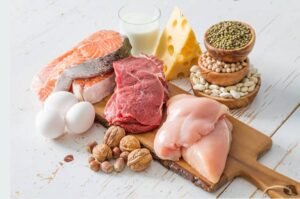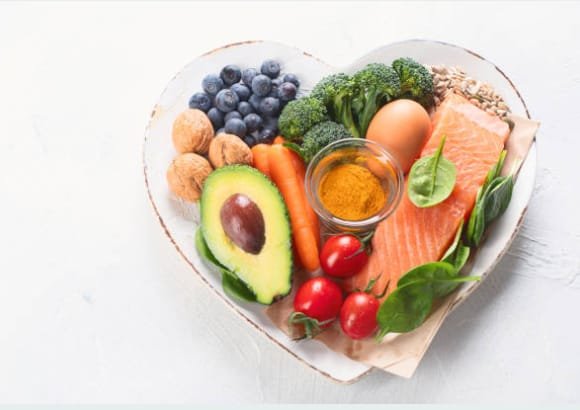
by admin | Jan 7, 2022 | Diet
plant protein| sources of protein for vegetarians
We can safely say that protein is the best-known nutrient in food for active individuals.
The benefits of it are nearly endless, especially for people involved in vigorous training.
Many cells, tissues, blood, and antibodies can be rebuilt using protein, which makes it a vital component of our recovery.
I mean, think about it – You ARE protein for the most part.
Most of your tissues, hormones, and enzymes are made up of some sort of protein.
But really, protein is a controversial topic, especially when it comes to the source of it.
In this article, we’re going to look at plant protein and tell you everything you need to know about it.
Now let’s get to it!
Plant VS. Animal Protein

There are two types of protein-containing foods – Complete and incomplete.
Whether they are complete or incomplete depends on the amino acid profile of that food.
Complete proteins contain all essential amino acids and are usually animal foods.
On the other hand, we have plant foods, which have an incomplete protein content, due to the fact that most plants lack certain essential amino acids.
Now, even though animal products are by far the easiest and most efficient way to get your full amino acid profile, you can do the same with just plants.
The simplest and best way to do so is to combine different sources of plant proteins (i.e beans and rice).
In doing so, you will allow each food to compensate for the lack of certain amino acids, in the food it is combined with.
This is in fact one of the main principles of vegetarian and vegan nutrition, as it allows you to meet your daily protein needs with ease!
Now, it is usually considered that plant-based individuals are severely deprived of protein.
However, this is not really a fact about vegan nutrition.
The fact is that if a plant-based individual has a rational, balanced nutrition plan, there will be no deprivation of protein!
The Best Plant Protein Sources

Nuts, peas, beans, soy products, and grain plants are some of the best plant protein sources that can replace conventional animal products.
Different proteins are found in these various foods, each with its own set of amino acids.
The facts? All of these products are at the top of the list of plant protein sources!
Nevertheless, there are MANY other plant products that you can use to meet your essential protein needs.
Below is a list of the most common plant-based products and their protein content (per 100g).
| Plant foods |
Protein content per 100 gr |
| Avocado |
2 |
| Asparagus |
2.2 |
| Almonds |
21 |
| Bananas |
1.09 |
| Beans |
21 to 25 depending on the type of beans |
| Broccoli |
2.82 |
| Brussels sprouts |
3.38 |
| Short grain white rice |
6.5 |
| Long grain white rice |
7.13 |
| Medium grain white rice |
6.5 |
| Mushrooms |
1.8 |
| Canned mushrooms |
3.4 |
| Green peas |
5.42 |
| Green beans |
1.82 |
| Green olives |
1.03 |
| Kale |
2 |
| Apricots |
1.4 |
| Non-peeled potatoes |
2.02 |
| Cauliflower |
1.98 |
| Long grain brown rice |
7.94 |
| Medium grain brown rice |
7.5 |
| Cashew |
18 |
| Kiwi |
1.14 |
| Iceberg salad |
1.2 |
| Dill |
1 |
| Wheat germs |
7.49 |
| Lin seed |
1 |
| Hazelnuts |
15 |
| Lentils |
26 |
| Pasta |
10.8 |
| Lettuce |
1.21 |
| Oats |
16.89 |
| Walnuts |
15 |
| Eggplant |
1 |
| Millet |
11.02 |
| Rye |
10 |
| Sweet potato |
1.57 |
| Soy |
36.9 |
| Spinach |
2.86 |
| Sesame |
18 |
| Pumpkin |
1 |
| Zucchini |
1.2 |
| Nuts |
26 |
| Peanut butter |
25 |
| Bread |
7.1 |
| Corn |
9.42 |
How Much Protein Should You Eat?

This is perhaps one of the most frequently asked questions in the fitness world, whether it’s about fat loss or muscle gain.
Now, there is no definitive answer to this question, due to the fact that we all process and use protein at slightly different rates.
Nevertheless, there are general guidelines, which recommend consuming 0.8-1g of protein per lb. of bodyweight.
The more muscle mass you have, the higher on that range you would be.
For instance, if you weigh 200 lbs and have 10% body fat, you would need right about 1g of protein per lb. of bodyweight.
Oppositely, if you weigh 200 lbs but are at 20% body fat, you’d need less protein.
Whether you’re trying to build muscle or lose fat, consuming ~1g of protein per lb. of body weight appears to be the optimal range, for both muscle gains and muscle retention.
Conclusion
Even though protein from animal foods is superior to plant protein, there really is no reason why someone wouldn’t be able to meet their protein needs by eating just plants alone.
Now, doing this is generally harder, but as long as you combine different sources of plant protein (i.e legumes, grains and beans), you will be good to go!
Ultimately, your best bet would be to consume up to 1g of protein per lb of bodyweight every day, derived from a variety of sources.
Whether you are meeting your needs or not, can be judged on how you perform, recover, and feel.
What is YOUR favorite plant protein source? Comment down below!

by admin | Jan 7, 2022 | Diet
How Good Is Your Protein? | Biological Value Of Proteins
When most people hear the term “protein,” they immediately think of a particular brand of supplement.
First and foremost, I’d like to emphasize that supplements are not the focus of this article.
Instead, we’ll look at different types of proteins and how they’re processed by the body.
It’s worth noting, however, that the protein you get from supplements and the protein you can find in food is almost the same.
The only exception is that certain powdered proteins are well-isolated and absorb more quickly than others.
That simply means that whey powders aren’t particularly potent or effective.
Supplements were designed to complement and improve your diet plan.
They’re also handy and can be used in a pinch, such as after a workout or even for breakfast if you’re running low on calories.
Let’s Talk Protein

As you probably already know, your body is technically a big, protein-based biological machine.
Aside from water, protein is the most common element we see in the body and more importantly, it regulates a variety of vital processes.
In a sense, protein is the building block of most of your tissues, enzymes, and hormones.
However, not all protein was made equal, meaning that the protein coming from different food sources, will be metabolized by the body in a slightly different way.
That is to say, there are high-quality sources of protein, but also, low-quality ones.
The Biological Value (BV) Of Proteins

Proteins’ biological value is used to determine how well they are digested, absorbed, and preserved by the body after consumption.
To put it simply, the biological value can be used to demonstrate the efficiency of the consumed protein.
Now, there are two primary measures that help us understand more about the biological value of proteins.
Firstly, we have the amino acid profile of each protein-containing food.
For those of you who do not know this, proteins are made from amino acids.
There are 20 amino acids, 9 of which are essential, meaning that the body needs them but can’t produce them on its own.
That is to say that the more complete a certain food’s amino acid profile is, the higher its biological value.
The second thing used to measure the biological value of proteins is protein retention, or in other words, how long the protein stays in the body.
The BV Standard
Now, in nutritional science, the biological value of proteins goes on a scale from 0 to 100.
Whole eggs (both yolk & egg white) are the standard for the biological value of proteins, measuring at 95-100 BV.
If we take the yolk out of the egg, the biological value drops with 5-10 points, down to 90-95.
With whole eggs being the golden BV standard, other foods are compared to them, in order to determine the bioavailability, as opposed to optimal quality protein (whole eggs).
Side note: Whey/isolate protein supplements have a BV of 100+.
Now, this theoretical information is important, but it brings us to the next logical question.
What Are The Best Protein Sources?
Below, we have listed the biological value of the most common protein sources we can find on the market nowadays, including both food and supplements:

- Whey isolate protein blends – 100-150 BV
- Whole eggs – BV 100
- Cow milk – BV 91
- Egg white – BV 88
- Fish – BV 83
- Beef – BV 80
- Chicken – BV 79
- Casein – BV 77
- Rice – BV 74
- Soy – BV 59
- Beans & legumes – BV 49
- Peanuts – BV 43
Now, what this 12-point table means for you, is that your primary sources of protein should be the ones on the top of the list, which have higher biological value.
Nevertheless, you can combine those with other, lesser bioavailable sources of protein, such as plant protein.
Ultimately, your best bet is to put a couple of food sources at the core of your protein intake, while also diversifying with a variety of other food sources.
Conclusion
The biological value of proteins (BV) tells us more about the amino acid content of each food, as well as how long its protein is retained in the body and how efficiently it is used.
Animal sources of protein appear to be superior, due to the better amino acid profile, as well as overall bioavailability.
This is why, if you are not vegetarian or vegan, foods like beef, eggs, fish, and chicken, should make up the majority of your daily protein intake.
If you have any questions, feel free to drop them in the comments below!

by admin | Nov 22, 2021 | Diet
GLUTEN FREE DINING AND COOKING– A good mindset helps
Gluten free cooking does not need to be the task a lot of us believe it’s going to be, and all gluten free food does not taste like cardboard.
You’ll be happy to knowJ
Make the effort to be familiar with the terrific gluten free dishes that are plentiful on the internet and in the many great cookbooks out there and start to include them one at a time into your cooking collection. You will be impressed at how terrific you feel along with how fantastic the food tastes.
If you need a gluten free ‘diet plan’ and have no idea where to begin or what you ought to be cooking you ought to have a look at the numerous gluten free coaching sites and blog sites online that deal with those concerns and you will be surprised what you find. In fact, you will most likely be astonished at the wealth of details that is offered. If you have a wholefoods shop in your location, many of them will stock totally gluten free items for your cooking requirements.
All the time there are more and more items, loose whole foods or pre-packaged foods that are designated for gluten free cooking. We are even discovering cookie and cake blends that are now gluten free in order to delight in some of the finer things in life, for those who would have been totally denied just a couple of years ago. Now you just don’t have to miss out!

Modifications are being made and resources are being shared through the Web that assist not just us adults that need unique gluten free cooking and diet plans but likewise support for the mums and dads of kids who need to have totally gluten free diet plans. That is why it is so important to look out for the numerous resources and dishes that are readily available for gluten free cooking.
Whilst living gluten free does have many constraints, and is frequently made rather more difficult by eating out, it doesn’t have to become a total headache.While on the one hand it is slightly annoying to not have the alternative of eating in every restaurant and it’s also pretty difficult at times to keep coming up with new things to cook, to avoid the same old thing, for means of staying safe, there still is a way to help you feel better and cope better.
Mindset – Yes, I said it. like everything the way we approach things will surely make a difference, to how we cope but also how we experience things as a whole.
You may even discover that you value the meals you have sometimes struggled to prepare, even more, because when you truly get a hang of it there is such a fantastic sense of achievement.

Try to see it as an adventure and take time to really research establishments and try different places, find new bloggers, recipes, and shops. Get cooking and baking together and get the family involved or if you live alone, just get cooking and invite people round to share your delights. You will soon discover a whole new world of food and rather than focus on what you can’t have, focus on what amazing things you are making and how much healthier you are going to feel.
The bright side though, for those who like dining out and need gluten free, is that increasingly more dining establishments are starting to acknowledge the condition and include choices that are totally gluten free.
Everything takes time, so be gentle with yourself, as stress will only exacerbate any intolerances or reactions you suffer anyway. So be gentle, go on a journey of food and self-discovery and you will be a gluten free master in no time and healthier to boot.
This article is for information purposes only and is not meant to treat or diagnose. Please consult a doctor or specialist nutritionist, or dietician, if you are gluten intolerant and need further advice.

by admin | Nov 19, 2021 | Diet
Types of muscles
Muscle Anatomy Basics PT 2 – Types Of Muscle Growth
As you learned in part 1 of this article series, our complex muscular system is made up of different types of muscle fibers.
We have fibers that allow us to go through low-intensity, long in duration activities like cross running, but we also have fibers that have a high power output, thus allowing us to do short, power-burst activities.
Now, this may lead you to this question – If there are different types of muscle fibers, are there different types of muscle growth as well?
And well, the short answer is- Yes, there are!
In this second part of the article series, we’ll explain just that, so without further ado, let’s get to it, by first answering an important question!
Why Do Muscles Grow?

Though it may seem quite simple, the question of muscle growth is quite baffling for many scientists.
And well, so far science has found that there are 3 main factors that affect muscle growth:
- Mechanical Tension
- Metabolic Stress
- Muscle Damage
Think of mechanical tension as the tension that your muscles go through, under the load you’re using.
This sets off reactions in the body that provide energy for each contraction, using energy substances like carbohydrates.
These substances, when broken down for energy, lead to the accumulation of byproducts – This accumulation, we refer to as “Metabolic stress”.
Ultimately, all of these factors combined lead to microdamage of the muscle fibers.
This, in turn, sets off a flurry of reactions in the body that recover the muscles, allowing them to reach their previous capacity… And then some more.
This is what we call gains! It’s just your body preparing for a bigger load on your next workout.
Is All Growth The Same?

As we mentioned, not all muscle growth is the same, as the training stimulus is your primary determinant.
When it comes to muscle growth, there are two main types:
- Myofibrillar hypertrophy
- Sarcoplasmic hypertrophy.
NOTE: Hypertrophy is just the scientific term for growth.
Think of myofibrillar hypertrophy as the growth of the muscle fibers, which are, the contractile units of your muscles.
This type of hypertrophy is mainly sought after by powerlifters and other strength athletes, as it primarily leads to increased relative strength (strength relative to your body weight).
Myofibrillar hypertrophy is mainly stimulated in the powerlifting rep range of 1-5 repetitions, close to your maximum strength capabilities.
On the other hand, we have sarcoplasmic hypertrophy, which is the growth of the sarcoplasm.
Think of the sarcoplasm as the jelly-like fluid that surrounds the muscle fibers (myofibrils).
This fluid contains non-contractile elements and provides energy for your muscular contractions.
Sarcoplasmic hypertrophy is mainly sought after by bodybuilding and physique athletes, due to its innate ability to increase the bulk growth of your muscles.
This type of growth can be stimulated if you use the bodybuilding rep range of 6-15 repetitions.
HOWEVER…
Volume Is Everything … !
Even though these two types of muscle growth are functional in different ways, the truth is that muscle growth will be practically the same, if your training volume is equated and the set is challenging.
Think of training volume as the total amount of weight lifted in a given set, exercise, or a workout (Weight * Sets * Reps )
To put it simply – In terms of growth, it doesn’t matter if you’re going to do 3 repetitions with 100 kg (300 kg volume), or 5 reps with 60 kg (Also 300 kg volume).
This is valid as long as you train with a challenging weight that brings you close to failure.
Final Thoughts
Muscle growth is something that happens when the body goes through resistance it has never experienced before.
Simply, growth is the body’s preparation for something it hasn’t experienced before.
Depending on the stimulus, you can achieve different types of growth.
In one of the instances, you will primarily gain relative and maximum strength (myofibrillar hypertrophy), while in the other instance you will primarily get bulk muscle growth (sarcoplasmic hypertrophy).
Choose your style of training, depending on the goals you have in mind!
If you care more about maximum and relative strength, focus on the 1-5 rep range to stimulate myofibrillar growth.
And of course, if you care more about how you look, rather than how much weight you can lift for one rep, focus on the 6-15 rep range and dip into the 1-5 range occasionally!

by admin | Nov 19, 2021 | Diet
Fast twitch muscle fibers
Muscle Anatomy Basics PT 1 – Types Of Muscle Fibers
The human body has a complex muscular system that is built from two main types of muscle fibers – Slow-twitch muscle fibers and fast-twitch muscle fibers.
Each of these types is suitable for different types of activities and in this article, we’ll dive into the details, so without further ado, let’s get to it!

SLOW & FAST-TWITCH MUSCLE FIBER
Muscle Unit Activation
Before we get to the types of muscle fibers, let’s talk about muscle unit (muscle fiber) activation!
The reason why you have different types of fibers in the first place is that the human body is capable of many different types of activities.
You can run for hours on end, but you can also do short-burst, quick sprints.
Think of it this way – The more you increase your training intensity (strain), the more muscle units you activate.
At about 75-80% of your maximum strength capabilities, nearly all muscle fibers (muscle units) are recruited and activated.
Going above that 75-80% mark is only possible via an increased frequency of the brain-muscle signals.
This implies that there is a very intricate connection between your muscle fibers and the central nervous system responsible for delivering contraction signals.
Now let’s have a look at the two types of muscle fibers!
Slow-Twitch Muscle Fibers

Slow-twitch muscle fibers are the muscles you use when you’re running a marathon or biking uphill.
They provide endurance and stability, but they aren’t really capable of high power output.
These types of muscle units have low force production capabilities, so their main function is to produce energy for long periods of time.
Slow-twitch muscle fibers are recruited when you are far from your maximum strength capabilities, or in other words, when the activity isn’t really strenuous but rather, requires endurance.
Fast-Twitch Muscle Fibers

On the other hand, Fast-twitch muscle fibers are what you use when doing short intense sprints, heavy lifting, climbing, and any other strenuous activity that demands a certain level of power and strength.
These units have a high power output and can contract really quickly which is exactly why they’re engaged during such quick, short power bursts.
What’s interesting about Fast-twitch muscles is that they have a high fatigue rate because their energy source ATP gets used up really quickly!
Furthermore, as opposed to slow-twitch fibers, this type of muscle unit has much greater growth potential.
What this means for you is that if you are looking for visual development, you should stimulate fast-twitch fibers!
How To Stimulate Fast-Twitch Fibers
To stimulate Fast-twitch fibers, you should primarily do high-intensity training, such as weight lifting, calisthenics, climbing, and sprinting.
Such activities allow you to get closer to your maximum strength capabilities, thus activating and stimulating the development of your fast-twitch muscle fibers.
Generally speaking, as a beginner/intermediate trainee, 5-10 challenging working sets, per muscle group, per week, should be sufficient for the goal of increasing the size and strength of your muscles.
How To Stimulate Slow-Twitch Fibers
On the other hand, to stimulate slow-twitch muscle fibers and develop endurance capabilities, you should engage in activities that utilize them.
Running, swimming, and skipping for prolonged periods of time is a great way of developing your slow-twitch muscle fibers.
Nevertheless, this type of training should be carefully implemented into your training routine, if you are mainly looking to improve your body visually, as well as strength-wise.
Final Words
So, to recap: Fast-twitch muscle fibers provide quick and powerful bursts of energy, while slow-twitch muscle fibers provide endurance capabilities.
Your training routine should be carefully planned out in a way that will tip the scales in favor of the goal you have in mind.
This means that if you want to look better and be stronger, you should primarily focus on quick, powerful bursts and fewer cardio activities, or the opposite if your main goal is endurance.
In part 2 of this article series, we’ll go through the 2 types of muscle growth, so if you’ve liked this article stay tuned!

by admin | Feb 28, 2021 | Diet
Why can’t you stick to a diet?.
You know what you need to do, but the motivation to stick to a diet is just not there.
Are you finding that you are always starting a diet on a Monday?. Why is it so hard to stick to a healthy eating plan?.

The difference between a diet and a healthy eating lifestyle.
Firstly, just the thought of starting and sticking to a diet is going to cause you anxiety.
There is an enormous amount of content out there that is promising the world. The truth is, getting to a healthy weight and staying there is never going to be achieved in 2 weeks.
A diet plan sold as a quick fix is never going to be a sustainable solution. The only way to ensure you succeed in adopting a long term healthy lifestyle is to change your food relationship.
Becoming one of “those” people who refer to carbs and proteins as opposed to bread and steak is a good thing, and this is why:
Knowing how your body responds to triggers.
 Firstly, understanding your body’s relationship with food is the start of a lovely journey. For many people, comfort eating is a real thing. When you find yourself upset, lonely, recently dumped, or stressed, food can replace a healthy alternative.
Firstly, understanding your body’s relationship with food is the start of a lovely journey. For many people, comfort eating is a real thing. When you find yourself upset, lonely, recently dumped, or stressed, food can replace a healthy alternative.
Once you can identify the triggers, you can circumvent the trip to the fridge instead of going for a walk around the block to clear your head and get some feel-good endorphins into your blood stream.
Knowing what your body needs.
Cravings are the worst when it comes to food. Having access to sugary foods when the craving hits just spells disaster. So the first step is not to have it in the cupboard.
You need to identify what your body is craving and fuel it with that. Instead of reaching for the easy option of a chocolate bar or bag of chips, stop and assess the hunger first.
Often, our bodies are looking for an energy boost. So an instant option is a sugary snack or coffee. Or your body could be asking for water as you may be dehydrated. Often, thirst is mistaken for hunger. So before you gobble down that pie, have a glass of water and wait 15 minutes for it to settle.
Fueling your body for survival.
Your body needs certain nutrients to operate at an optimal level. This is a combination of minerals, vitamins, carbohydrates, and proteins. If you have too many of one and not enough of the other, your body’s balance is out of . For instance, if you eat too many carbs, not using them for fuel by being active enough turns them into sugar, storing as fat.

Eating just the right amount of food that your body needs to function is essential to managing your weight. If you are sedentary, your plates need to be far smaller than running around all day for work or sport.

You cannot out-train a bad diet.
Even the best athletes in the world cannot out-train a lousy eating plan. Eating too many refined carbs (bread, cakes, pasta, etc.) adds to belly fat. It collects around your organs, making them work so much harder to function. Putting this unnecessary strain on your body reduces the functions of your organs.
Measuring your calories in vs. your calories you are burning over the day gives you an indication of what you should be eating.
Knowing what each meal contributes to the calorie count will soon get you to make different decisions when it comes to choosing what you put in your mouth.

Being honest with yourself.
Fast food does not make you feel good. Making excuses to the contrary is a mind game you won’t win.
The long term effects of fatty food that may taste good going in is something you need to think about. Being a parent, partner, or business owner, you owe it to your family and co-workers to be healthy and available to them.
If you want to start tracking what you are eating, have a look for one of the many apps that measure your food and activity.
Daily monitoring of your intake and output will make a real difference to your understanding of food, and ultimately your relationship with it.





















 Firstly, understanding your body’s relationship with food is the start of a lovely journey. For many people, comfort eating is a real thing. When you find yourself upset, lonely, recently dumped, or stressed, food can replace a healthy alternative.
Firstly, understanding your body’s relationship with food is the start of a lovely journey. For many people, comfort eating is a real thing. When you find yourself upset, lonely, recently dumped, or stressed, food can replace a healthy alternative.








